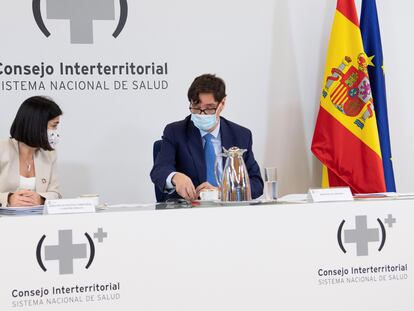Over 20,000 people died of coronavirus in Spanish care homes during first wave, government report says
Draft study provides the first official estimate of fatalities that made world headlines when elderly residents were found in a state of neglect at understaffed centers

The Spanish government estimates that there were 20,268 deaths from coronavirus at social services facilities for the elderly and for people with disabilities between early March and June 23, during the first wave of the pandemic.
The figure is included in a draft report that EL PAÍS has seen, and which says that 10,364 of the victims underwent a blood test, while 9,904 had symptoms compatible with Covid-19. Between 47% and 50% of deaths during the first coronavirus wave took place at social services residences, according to the report.
The death estimate, made by the Office of the State Secretary for Social Rights using data provided by regional authorities, represents the first official figure reflecting what happened inside Spain’s care homes as the country struggled to deal with the first wave of the pandemic.
While citizens were confined to their homes in one of the world’s strictest lockdowns, news began to emerge about “seniors in a state of complete abandonment, when not directly dead in their beds,” according to military emergency units that were sent in to provide medical and cleanup assistance.
Amid a mounting scandal, social services representatives underscored the precarious working conditions at care homes, where “workers are putting themselves on the line, without resources, without healthcare support, without protective gear.” Public prosecutors launched an investigation.
The “perfect storm”

The report analyzes 30 factors that played a role in what is described as “a perfect storm.” These factors range from the highly infectious nature of the virus to the size of the care homes, the lack of personnel, and the “erroneous perception” that senior residences would be able to deal with the situation by themselves.
The document, dated November 1 and drafted by a working group answering to the Office of the State Secretary for Social Rights, has been sent to regional authorities and social services leaders for discussion and additional information.
During the first state of alarm, which began in mid-March and ended on June 21, Spanish health authorities drew up a report on the situation in care facilities, but this study was never released. In July, an internal document – a “draft,” according to the government – estimated the number of deaths at 18,833 and criticized the poor quality of regional statistics.
This latest study notes that there are still some gaps due to the lack of “robust and homogeneous data among territories.” Despite this, the working group has arrived at a figure of 20,268. No information is provided about how many of these deaths occurred at senior care homes as opposed to centers for people with disabilities, but it is assumed that they represent the majority of cases.
The document underscores the “extreme vulnerability” of care homes and notes that even though fewer cases are being recorded during the second wave of the pandemic, these centers need to be prepared for potential worsening scenarios. The study also notes the “very negative effects” of isolation on the health of residents, and urges that confinement measures only be adopted when “inevitable.” Restricting visits as a standalone measure has not protected centers from infection, it adds.
The report underscores “the low salaries and poor-quality jobs” at these centers, as well as insufficient health personnel to deal with a pandemic. The authors urge authorities to “connect” these centers with the primary healthcare system to ensure better coordination and resources.
English version by Susana Urra.
Tu suscripción se está usando en otro dispositivo
¿Quieres añadir otro usuario a tu suscripción?
Si continúas leyendo en este dispositivo, no se podrá leer en el otro.
FlechaTu suscripción se está usando en otro dispositivo y solo puedes acceder a EL PAÍS desde un dispositivo a la vez.
Si quieres compartir tu cuenta, cambia tu suscripción a la modalidad Premium, así podrás añadir otro usuario. Cada uno accederá con su propia cuenta de email, lo que os permitirá personalizar vuestra experiencia en EL PAÍS.
¿Tienes una suscripción de empresa? Accede aquí para contratar más cuentas.
En el caso de no saber quién está usando tu cuenta, te recomendamos cambiar tu contraseña aquí.
Si decides continuar compartiendo tu cuenta, este mensaje se mostrará en tu dispositivo y en el de la otra persona que está usando tu cuenta de forma indefinida, afectando a tu experiencia de lectura. Puedes consultar aquí los términos y condiciones de la suscripción digital.
More information
Últimas noticias
Most viewed
- Sinaloa Cartel war is taking its toll on Los Chapitos
- Oona Chaplin: ‘I told James Cameron that I was living in a treehouse and starting a permaculture project with a friend’
- Reinhard Genzel, Nobel laureate in physics: ‘One-minute videos will never give you the truth’
- Why the price of coffee has skyrocketed: from Brazilian plantations to specialty coffee houses
- Silver prices are going crazy: This is what’s fueling the rally










































